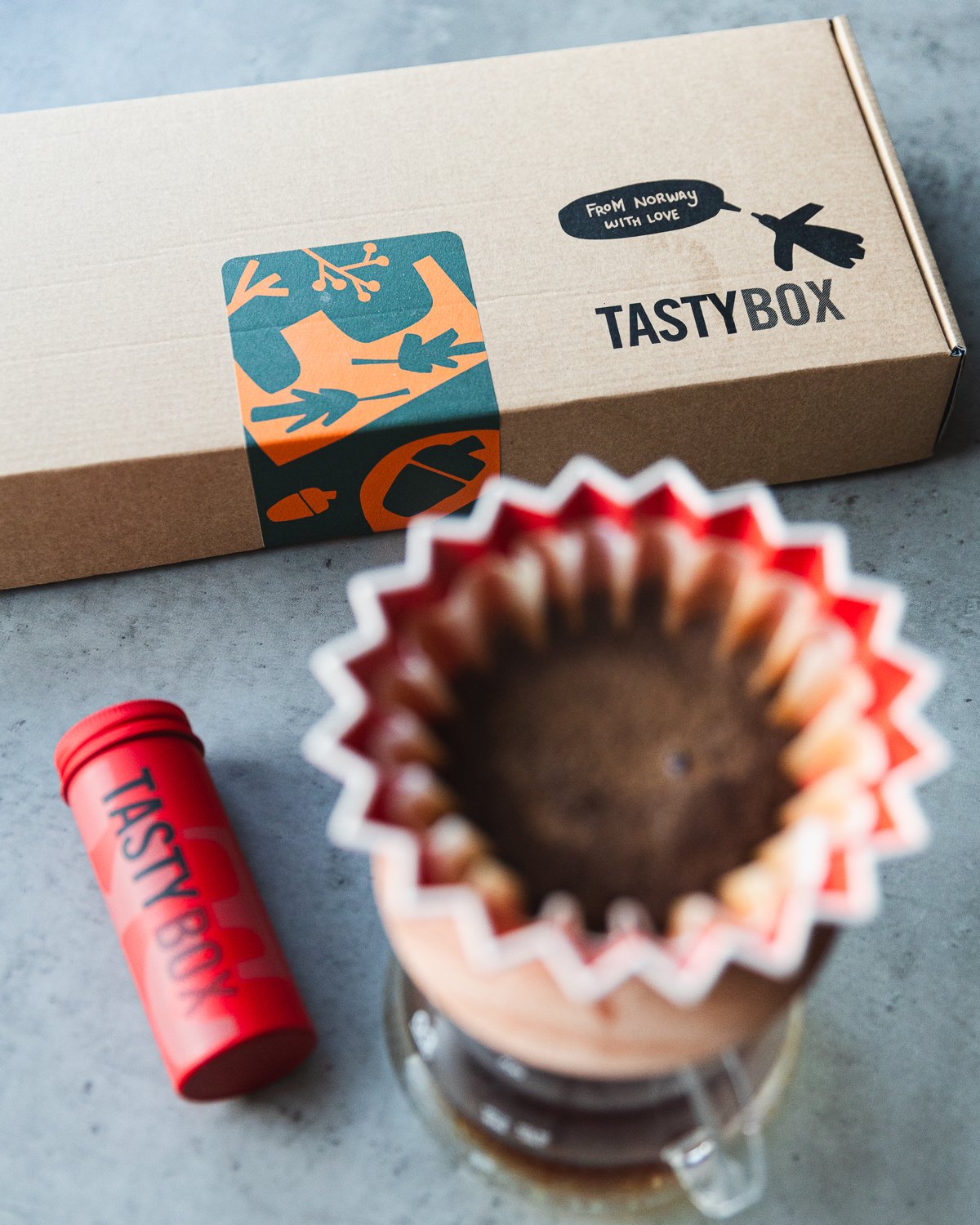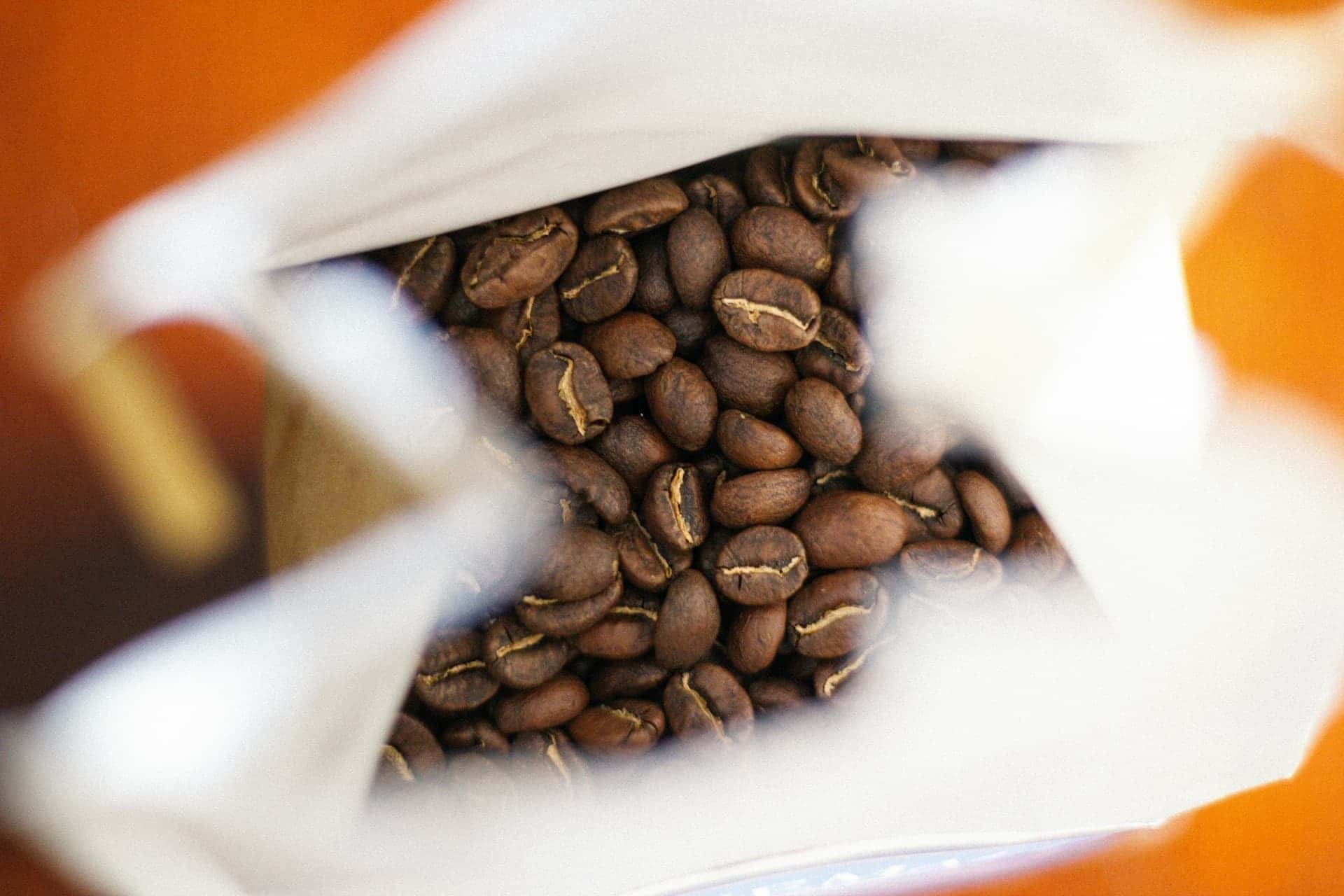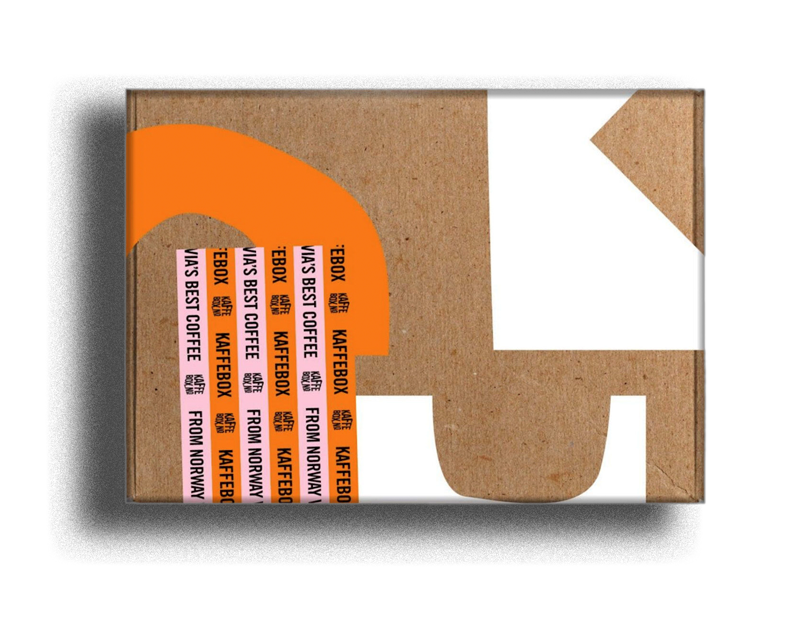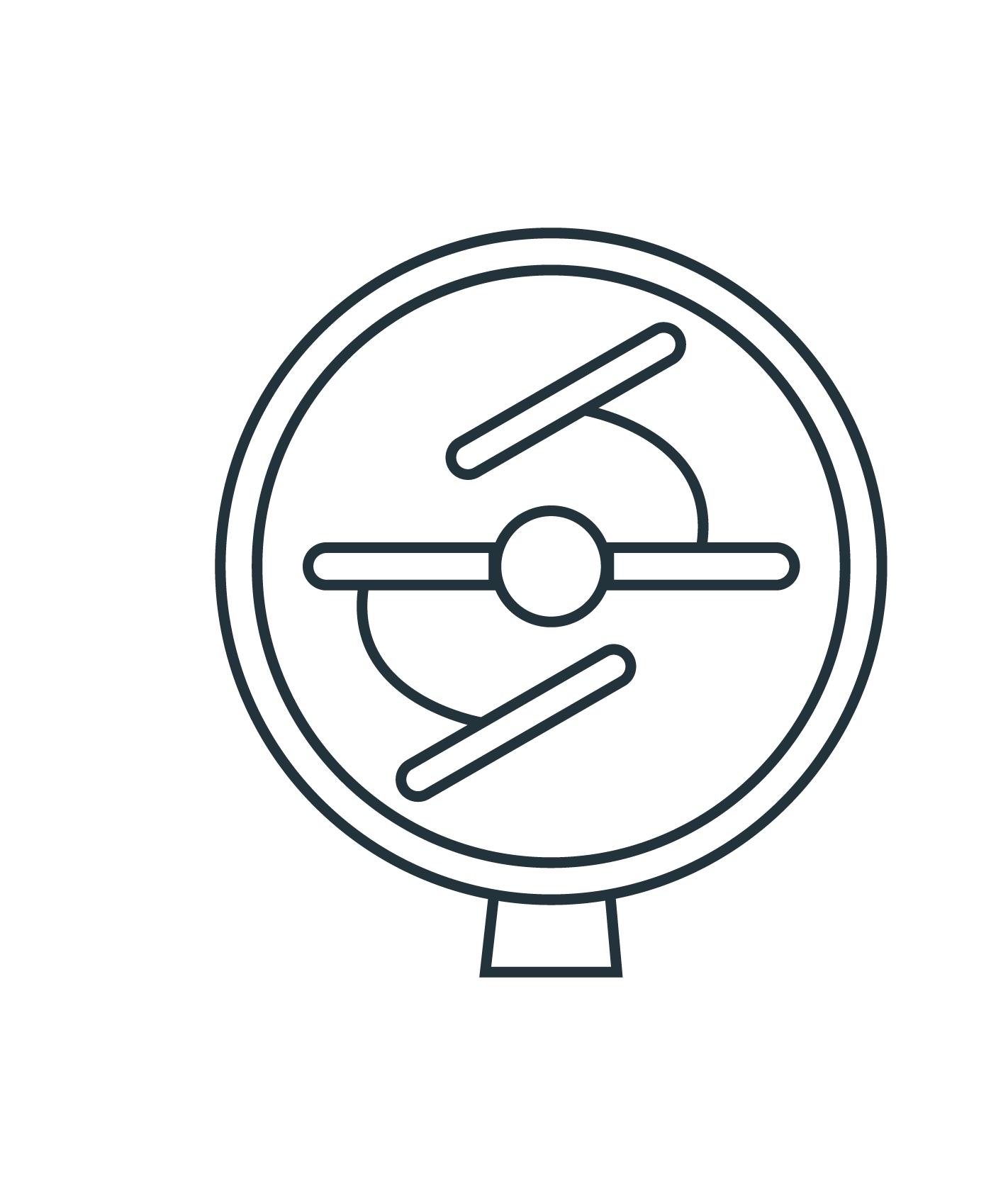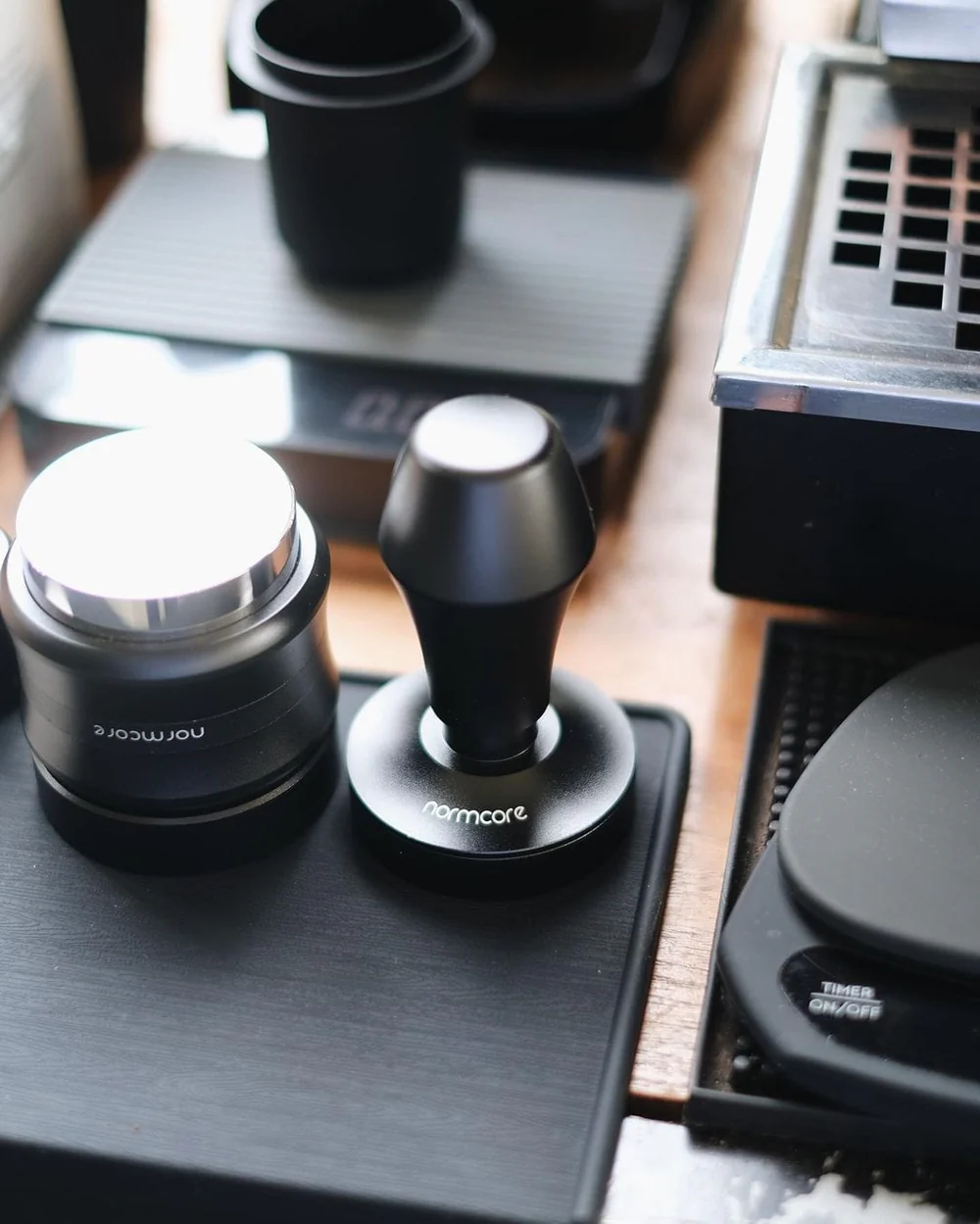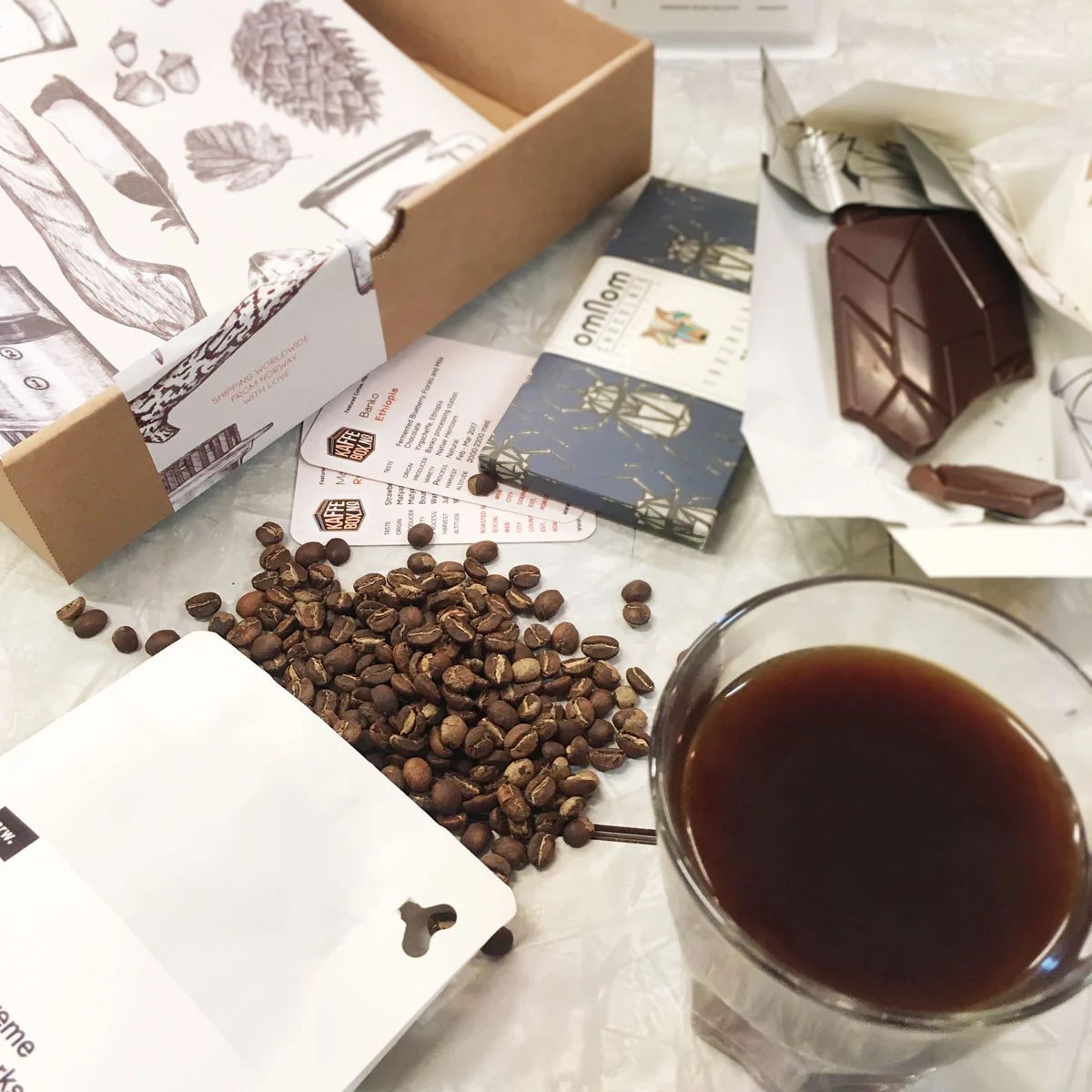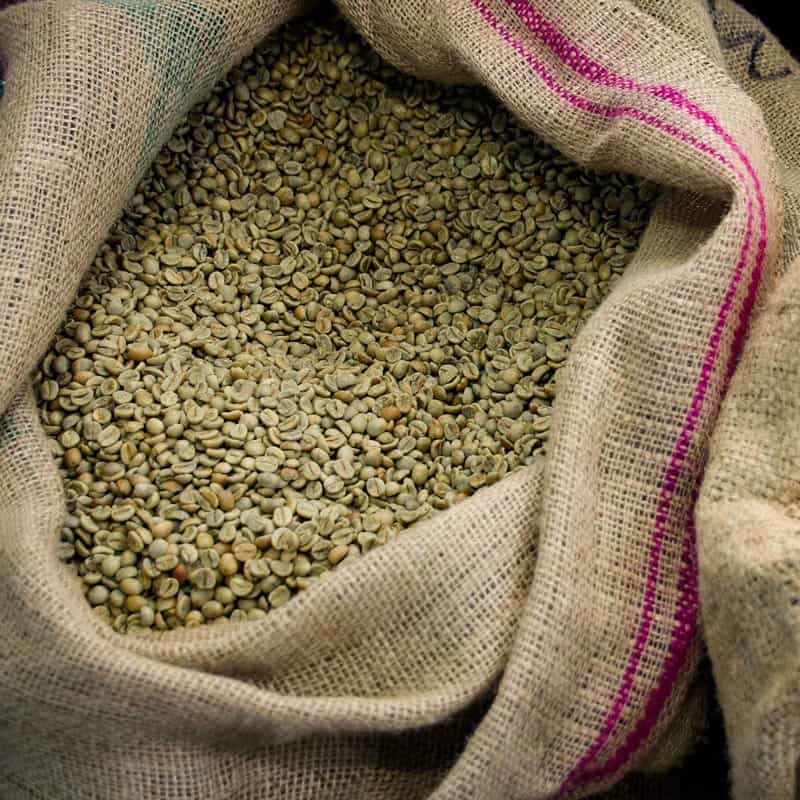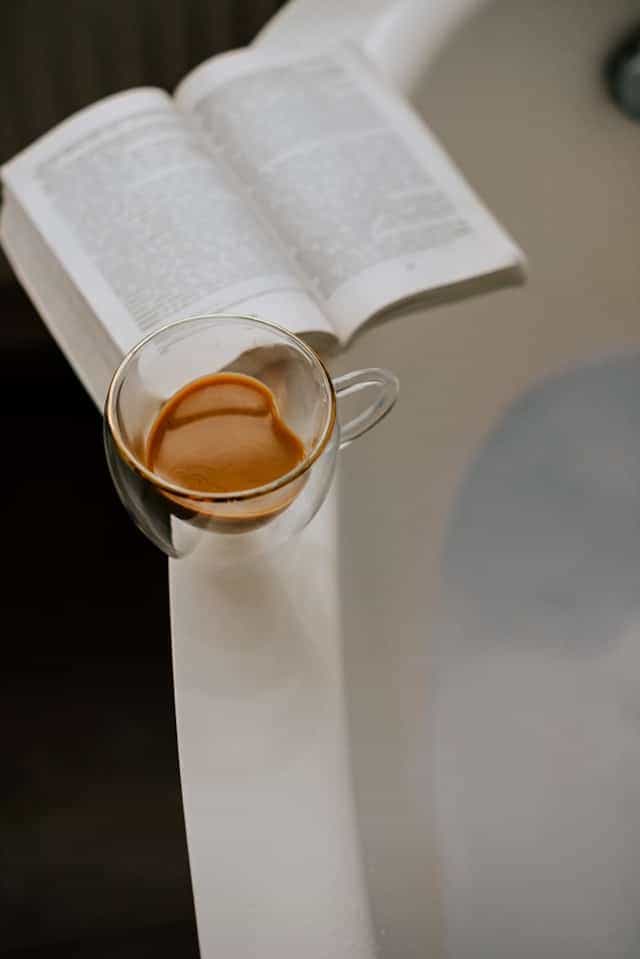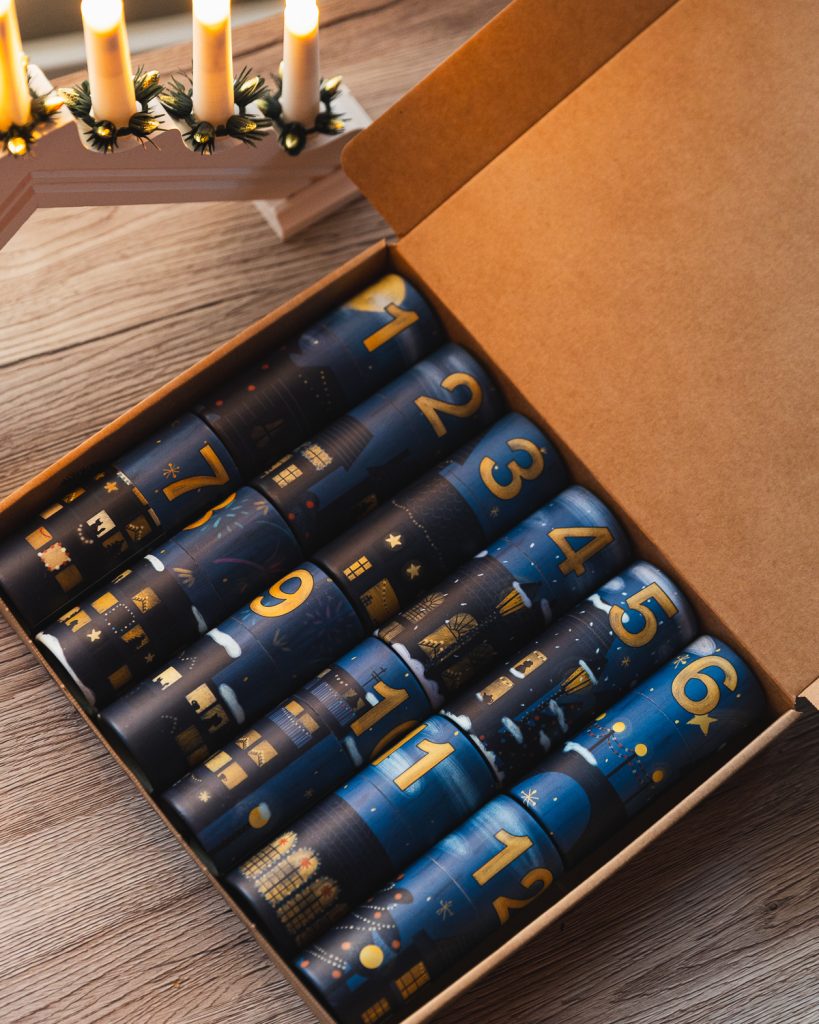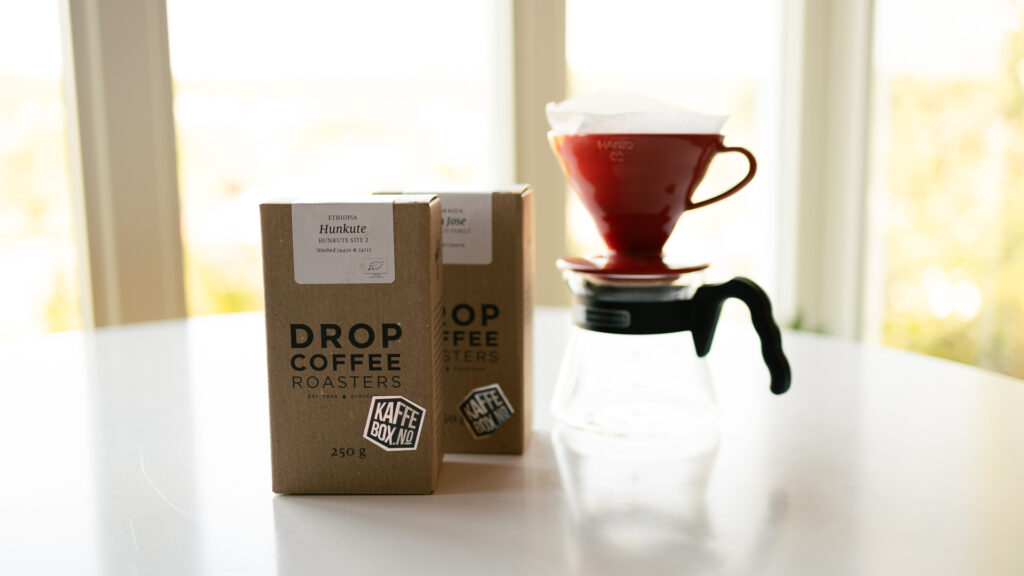Meet the Roaster
Meet the Roaster: Drop Coffee
Drop Coffee, founded in Stockholm, Sweden, in 2009, began as a coffee bar dedicated to serving tasty coffee. A year after opening, they started roasting their own beans using a small 1kg roaster in the back of their shop. In 2012, they upgraded to a 25kg Diedrich roaster and moved to a dedicated facility to cater to wholesale customers. By 2018, Drop Coffee had relocated their roastery to Rosersberg, just north of Stockholm, where they now operate as a fully certified organic roastery.
We firmly believe that our roasts can only be as good as the raw beans we source.
– Mikael Ayele
We only roast the best of the best – coffees we truly love and have carefully acquired from experts we trust, admire and know personally. We firmly believe that our roasts can only be as good as the raw beans we source, and that full transparency in coffee trade and business practices is essential to the long-term viability of the entire industry. As such, we regularly visit all of the producers we work with abroad, and have even hosted some of them at home here in Sweden. While tirelessly seeking out the choicest beans (must have a cupping score of 87 or higher) and distributing risk evenly across the entire supply chain, we pay several times more than the so-called “commodity price” for all the coffees we purchase. We always disclose the FOB prices we’ve paid and also publish an annual sustainability report, which we encourage all to read on our website.
Most of our days are spent roasting to order, in small batches of 8-16kg on our Diedrich IR-25 roaster. This approach not only ensures maximum freshness, but also zero waste. We pay extremely detailed attention to sweetness, clarity and vibrancy and aim to display every coffee’s distinct origin and individual personality at front and centre. To achieve this, we never blend lots and stick to a light to medium roast profile, which we tailor to bring forth as much of each bean’s natural acidity and sweetness as possible. We also do not differentiate our roasts based on the intended brewing method, but rather focus on an omni-roast profile that’s equally exceptional on espresso as it is on filter. Some coffees will inherently taste crisp and juicy, while others will feel more creamy and chocolatey. Regardless, we always push for utmost brightness, flavour, and consistency, resulting in delicious, vibrant coffees that reflect all of the wonderful people behind them.
What can you tell us about the coffee you’ve selected for us this month?
Hunkute Washed Organic, Ethiopia
Hunkute is an extremely special coffee to us at Drop Coffee. We’ve been buying and roasting Hunkute for over 13 years, so it plays a huge role in our portfolio as well as our history.
– Mikael Ayele
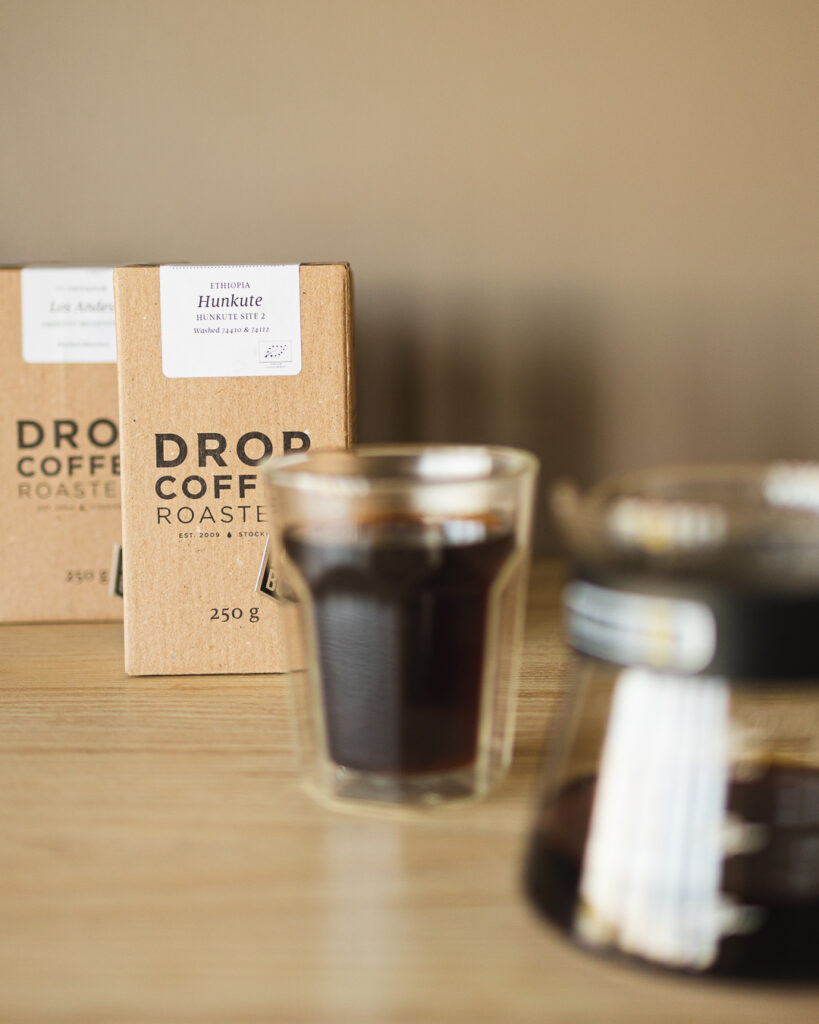
Hunkute is located in the Dalle region in Sidamo and is made up of two washing stations (site 1 & site 2) where the coffee is processed and belongs to the Hunkute Sidama Cooperative, which is made up of 2149 members, most of whom are small-scale farmers from the surrounding area. This harvest is from Hunkute Site 2, which is located at 2150 masl.
Hunkute is fully organic certified and like no other coffee we’ve ever come across. With a bright aroma of black tea, Hunkute brews a well-balanced and delicate cup, with fruity flavours of apricot and Assam tea. It has medium-high citric acidity and a finish reminiscent of fresh peach, with hints of white flowers. The body is light and smooth like iced tea. It’s no surprise many longtime Drop Coffee drinkers hold this as one of their favorites. We certainly do too and couldn’t think of a better coffee to lead our Kaffebox lineup.
San Jose Natural Caturra, Nicaragua
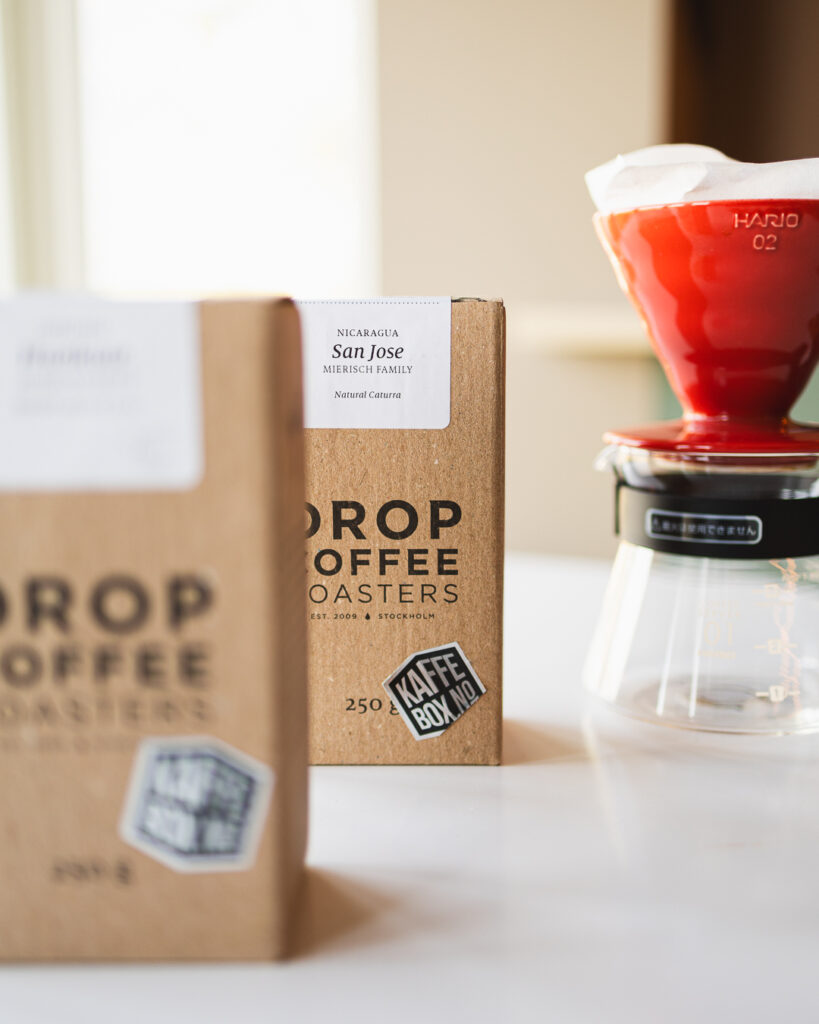
San Jose is a 46 hectare farm located in the mountains of Jinotega in Nicaragua. Here at 1250masl to 1400masl, an unusually high altitude for growing coffee in Nicaragua, an extremely diverse assortment of varietals are grown (Javanica, Yellow Pacamara, Gesha, Catuai, Yellow Pacas, and in this case, Caturra). San Jose farm is run by three generations of the Mierisch family, who are not only experts at producing outstanding coffees, but are very active in social projects to improve the quality of life for their workers and community. For example, they have a full-time kitchen staff who provide free meals for their employees on-site, and have even built daycare centers and schools for their children to attend while at work.
San Jose Natural Caturra is a steady yet complex coffee, with a sweet aroma reminiscent of strawberry lemonade. It has tasting notes of frozen strawberries and honey nougat. With a juicy body and medium weight, San Jose offers a crisp finish like that of Pink Lady apple. A perfect choice to enjoy hot or cold on a warm summer day!
Los Andes Washed Bourbon, El Salvador
Produced exclusively for Drop Coffee by our longtime partner and Cup of Excellence winner, Ernesto Menéndez, Los Andes is an outstanding coffee that showcases just how different a varietal can taste simply based on the terroir in which it was cultivated. At the 5 hectare Los Andes farm, this Bourbon varietal is grown “wild” alongside their SL28 trees, some of which are now almost 80 years-old. This is not only atypical, but results in a mature sweetness and bigger mouthfeel than we’re used to experiencing in El Salvadorian coffees. Ernesto recently visited us in Stockholm and said the Americano he had at our cafe was the best in his life.
Brewing Los Andes Washed Bourbon you can expect a nutty aroma, followed by a juicy, bright and clear cup. It has a medium acidity reminiscent of lime juice, with sweet notes of ripe red apple and freshly-baked almond cake.
Limoncillo Washed Caturra, Nicaragua
Limoncillo farm is located in the stunning Matagalpa region of Nicaragua, and consists of a massive 119 hectares, of which 54 acres are protected rainforest. Here over five different coffee varietals are grown amongst lush forest and even nine waterfalls. Limoncillo farm is run by three generations of the Mierisch family, who are not only experts at producing outstanding coffees, but are very active in social projects to improve the quality of life for their workers and community. For example, they have a full-time kitchen staff who provide free meals for their employees on-site, and have even built daycare centers and schools for their children to attend while at work.
Over the five years we’ve been buying it, Limoncillo Washed Caturra has become one of the staples in our lineup. It’s no wonder – it is an absolutely steady, comfortable and satisfying coffee. Limoncillo delivers notes of roasted hazelnut, sweet toffee and has a lingering finish of cacao nibs. It’s this chocolatey and round flavour profile that has helped make it a Drop Coffee customer favourite, especially served on espresso.
Ana Sora Washed, Ethiopia
Ana Sora is the highest-grown coffee from Drop Coffee, with its farm situated at an altitude of 2350 masl in the Guji region of Ethiopia. The varietals planted at Ana Sora are 11/714 and 74120, which are hybrids of indigenous landrace. Due to the high elevation, the coffee cherries grown here not only mature slower, but also take longer to ferment and to dry during processing, which ultimately results in lots of acidity and vibrancy that we absolutely love. While most coffee grown Ethiopia comes from cooperatives, Israel Defga, our partner since 2016, established his own private farm called Kerchanse Trading Company. Over the years he’s worked hard to get his community out of poverty through coffee, creating new opportunities by opening process stations in hard-to-reach areas where no other work existed, improving local roads, sponsoring a local orphanage and offering free agricultural education to students.
Drinking Ana Sora Washed is like sipping a cup of citrus fruit juice. It has an enticing aroma of pomelo and bergamot, and distinct notes of lemon zest and black tea. With hints of papaya and white florals and a long-lasting vibrant acidity, Ana Sora Washed has a juicy, almost fizzy mouthfeel that reminds us of Fanta Lemon. This year’s harvest was extremely popular and we had to specially reserve some for Kaffebox before it sold out!
Do you have a recommended brew recipe for the coffee?
One of the benefits of our light, omni-roast method is that you can enjoy every one of our coffees in any and all brewing methods, without compromising their inherent clarity or brightness. We encourage you to experiment with brewing them all in as many different ways as you can. In doing so, you’ll be able to explore and compare the mouthfeel and flavour notes in different intensities and ultimately choose for yourself what is best.
We will say that here at the roastery typically start our day with a hand pour-over. We personally use a Kalita Wave Dripper, but the following recipe will work well for most manual pour-over systems (ie Hario V60, Chemex, etc).
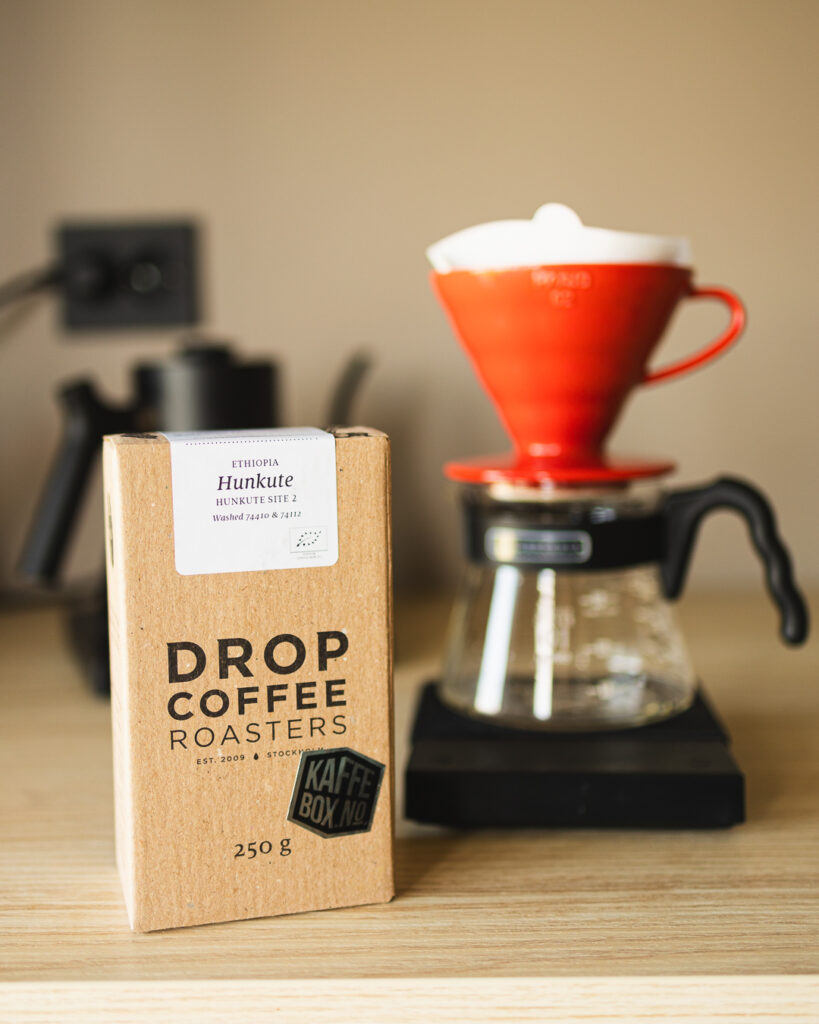
Small Kalita Filter 155
15 grams coffee, ground slightly finer than granulated sugar
250 grams water above 96 degrees C
Brewing time: 2:45 – 3 minutes
Brew on a scale and use a timer
- Pour 40-50 grams of water over the coffee, make sure all coffee gets wet, and starts brewing.
- Wait for 20-30 seconds to allow the coffee to “bloom” (release carbon oxide). Depending on how freshly roasted the coffee is this may take slightly longer or less long. When the coffee stops bubbling, pour water up to 100 grams
- After 1 minute, pour up to 150 grams
- After 1.30 minutes, pour up to 200 grams
- Pour the last water, up to 250 grams after 2 minutes
- Once all water has finished running through, remove the filter holder, gently swirl and pour your freshly brewed coffee.
Extra tips for an even better brew
- Rinse the filter paper with hot water before you start brewing, this is to remove any possible paper taste and also to preheat the filter holder.
- If your coffee gets an obvious bitter taste, try grinding the coffee slightly coarser next time for a better result.
- If your coffee starts tasting sour, try grinding the coffee slightly finer to extract more sweetness and bitterness from the coffee and balance the cup.
- Keep in mind to never let the coffee dry out during the brewing, always pour new water over the coffee before the old has run through completely.
- Avoid pouring on the sides, work towards including all the coffee in the brewing.
For those with an espresso machine at home (luck you!), feel free to try out the following guidelines that baristas often use at our café. Keeping in mind making espresso is a craft in and of itself, and you need to work a lot to find the right settings.
Double Espresso
Coffee: 18g
Brewed Weight: 40g
Extraction time: 30 seconds
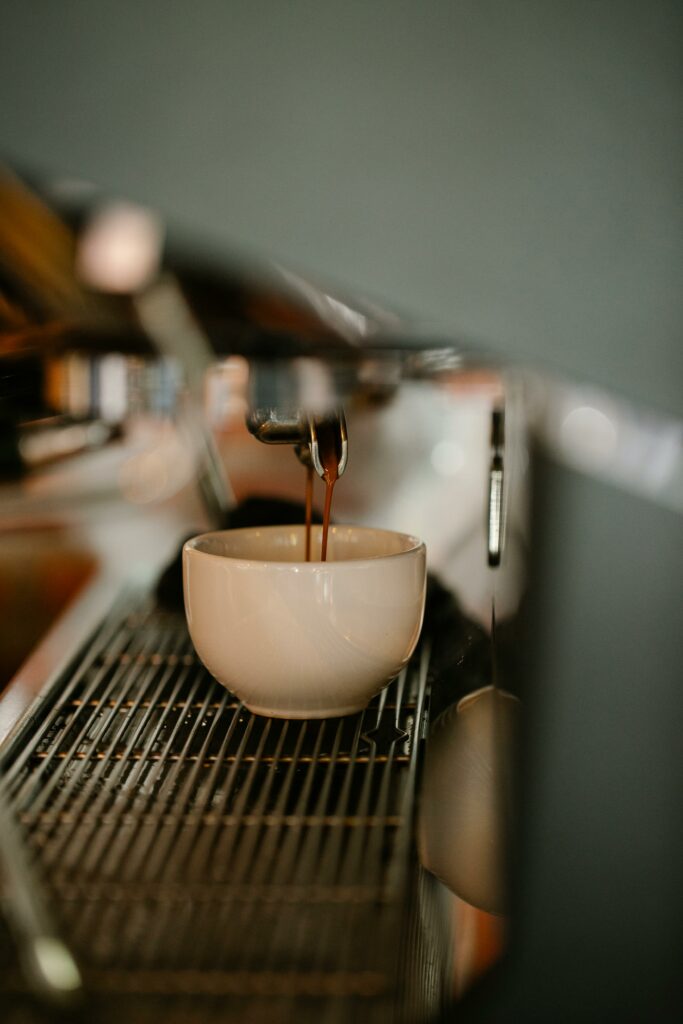
Photo: Michael Burrows
- Weigh the coffee into the portafilter.
- Weigh the amount that comes out as espresso.
- Use a timer to see how long it takes to brew the espresso. Taste.
- If it is running too quick, set the grinder slightly finer, if it is running to slow, set the grinder coarser. Taste again.
- Adjust accordingly and repeat until desired taste is achieved.
What is your personal favorite brew method?
Having grown up in the stunning natural landscapes of the Dalarna region of central Sweden, our Managing Director, Joanna, swears by brewing “Kokkaffe” (Cowboy Coffee) outdoors. In her opinion it’s not just easy to brew, requiring only a kettle, but is one of the most peaceful ways to enjoy coffee and benefit from its rejuvenating qualities.
To brew:
- Use 65 grams per liter, ground to the consistency of granulated sugar
- Pour the coffee directly into the kettle (water should be approximately 96 degrees) and gently stir so all of the coffee is covered by water. Let it sit for 4 minutes.
- Strain the coffee or simply let the grounds settle, then gently pour coffee into your favourite mug.
Kokkaffe is best enjoyed outside on an open fire, surrounded by loved ones and nature.
What music do you listen to while roasting?
Lucky for us, our head roaster, Laura, and assistant roaster, Jack, have an extremely varied and eclectic taste in music that keeps us all motivated (and singing) throughout the day. During the roasting and packing of these coffees for Kaffebox, our roastery was filled with the tunes of everything from the latest Eurovision pop hits to early 2000’s R&B to old school rap. It felt especially fitting to finish it all with “Final Countdown” by 80’s Swedish rock sensation, Europe.
Spread some love! Apart from your roastery – who’s your favorite roaster and why?
3Fe Roasters in Ireland. Call us partial, but we appreciate and respect their approach to focusing on only top quality coffees while forging mutually beneficial relationships with their suppliers. Even though they’ve grown tremendously over the years, they haven’t lost touch with their small, independent approach to sourcing, and constantly surprise us with their unique coffee discoveries. They’re also fantastic at presentation; on a recent visit to Dublin, our Assistant Operations Manager, Mikael, was blown away by his experience at one of their cafés.

